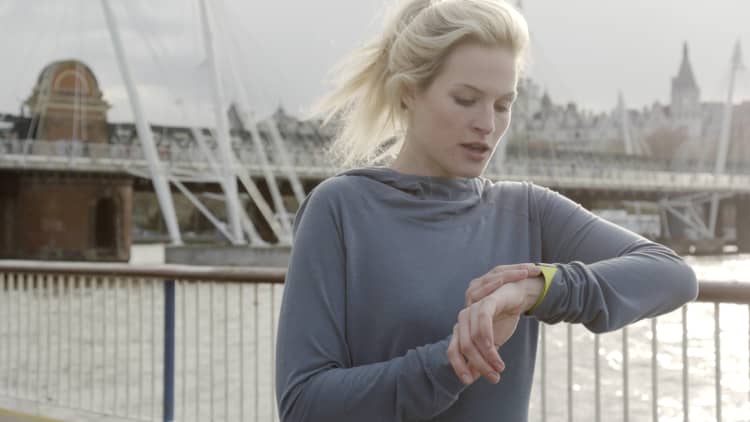You know the old adage, "If you want something done, give it to a busy person"? Liz Danzico embodies that law of human productivity.
As NPR's first creative director, she splits her time between offices in New York and Washington, DC, where she oversees all the visual and user experience across the station's branded digital platforms and content. At the same time, she is the chair and co-founder of School of Visual Arts' MFA program in interaction design, availing herself to students during evening office hours.
So how does the designer, educator, and Magenta contributor manage to carve out time for her family and even herself? An early wake-up time, just for starters.
More from Belinda Lanks:
How the Man Behind Giphy's Crazy Growth Stays Productive
How NASA's Cinematographer Taps into the Right Stuff
10 Warning Signs of Toxic Clients
The sun also rises
I'm fascinated with watching the sun come up. If I've seen the sun rise, I've conquered the day. Something about having a really solid connection with your city — for me, New York — before anybody is up is inspiring. I wake up with an alarm at 6:00 a.m. and immediately, before doing much of anything, try to get out for a run with my dog. I think of running as active meditation — clearing my mind while being in motion. Then I come back, check email, eat breakfast, have coffee, shower, and I'm off to the subway around 8:30.
That is, when I'm not traveling to D.C. On the days I travel to D.C., I wake up somewhere between 4:00 and 4:40 a.m. I do stretches but no running, pet and feed the dog, and get out the door by 5:00 to arrive at the office by 9:00.

Concentric meetings
I am obsessed with structure in my day. I've tried all the things — saying no meetings on Mondays, not checking email before noon. What I do now is have a ton of standing meetings to make sure that I'm talking to a good balance of people over the course of a week. If the goal of my job is to help other people do theirs better, then how many conversations can I have to help further that goal?
I organize meetings like concentric circles. At the center are one-on-ones with all the people on my team every week, and I spread those out in the afternoons over the course of three days. There's a bigger circle that has a team, then a larger circle that has the discipline, and then there's the giant circle of the organization.
I'd say twice a week I meet with someone completely outside of the circles of any of those things I do. That could be a student, or it could be someone who has a new idea or wants to pitch a product.
That said, I have almost no control over my calendar.
Undoing a creative block
Whenever I can't seem to write, I just start writing anything — the same word over and over, a sentence copied from a book, because the act of writing itself is one of the blocks. For other kinds of blocks, I get inspiration from people outside of my purview of design, journalism, and media. Hearing what somebody else is up to leads me to discover some piece I've been missing. These adjacencies really help inform one another.
Listening to someone super excited or super boring — someone extreme — can be a kick-start to going back to what I'm doing.
Just one thing
I've found that my brain works better and faster if I just do one thing at a time. When I'm talking on the phone, I'm looking out the window, not sitting at my desk in front of my computer. If I'm in a meeting, I'll sit with my back to the door. If I've written something and need to proofread it, I'll print it out or PDF it and put it on some other device besides my computer.
Feeding the introvert
I've tested as an introvert in every personality test I've ever taken. But I absolutely love to be around people, so I have to make sure that for every intense day I have, which feels like every day, that there is time carved out for myself. I like taking myself out to lunch or dinner and occasionally breakfast, so I can have quiet time reading or thinking or doing nothing.
Creative mentor
Steven Heller, my founding co-chair of the MFA Interaction Design program at School of Visual Arts, is influential and an inspiration to me on so many levels. He's done a number of objectively impressive things, like was the art director of the New York Times Book Review for thirty-some years. And he's written/edited over a hundred books at this point.
He's also constantly authoring articles and giving talks. But you'd never know that because when you're in a room with him he's very good at making you feel like you're the only priority he has. He never checks his phone, runs out to another meeting, or acts as if you don't matter. This ability to make people feel like the most important thing at that moment is something that I've tried to emulate.
Advice to my younger self
To my less experienced self I would say to think less and do more. As I've gotten older, I've been more prone to trying things instead of researching the hell out of them, thinking about them, diagramming them, then waiting two years before testing them. Now I try to have a balance between exercising my over-analytical muscles and just trying something out.
This article originally appeared on Magenta.
Belinda Lanks is an editor and creative lead at Huge and Magenta.


